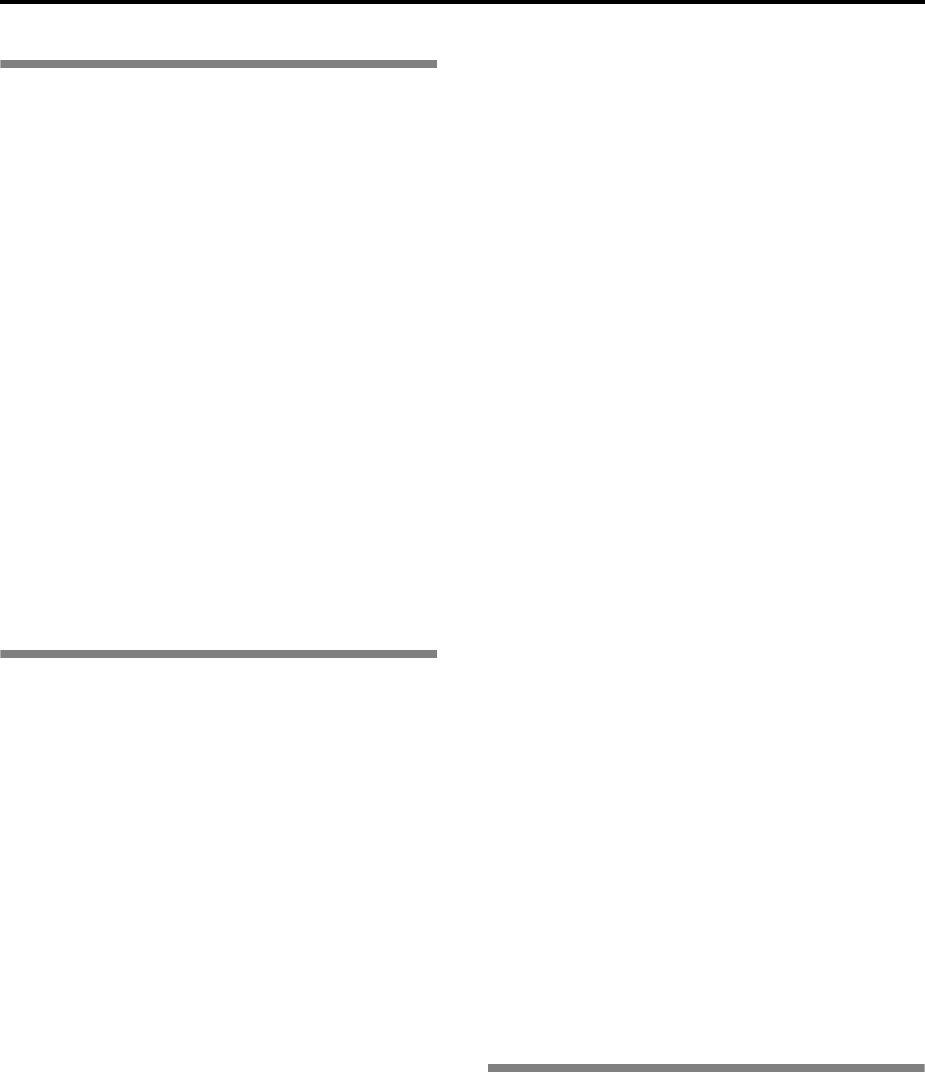
122
Playing the TRITON multi-timbrally
from an external device
The TRITON can be connected to an external device
and played multi-timbrally in the following ways.
• MIDI messages from the external device can play a
combination (8-part multi-timbral performance).
You can change the overall settings (programs,
levels, and effects) by using program change
messages to switch combinations.
• MIDI messages from the external device can be
used to play a song (using the TRITON as a 16-part
multi-timbral tone generator). However if the
Global P1: MIDI “MIDI Clock” is INT, it will not
be possible to switch the overall settings.
• MIDI Clock messages from the external device can
be used to make the TRITON playback a song (set
“MIDI Clock” to EXT, and run the TRITON’s
sequencer). (
☞“Synchronizing the playback of the
arpeggiator or sequencer”) You can change the
overall settings (programs, levels, effects) by using
song select messages to switch songs.
Synchronizing the playback of the
arpeggiator or sequencer
The choice of whether the TRITON will be the master
(the controlling device) or the slave (the controlled
device) is made by Global P1: MIDI “MIDI Clock.”
Using the TRITON as master and the external
MIDI device as slave
Connect the TRITON’s MIDI OUT connector to the
MIDI IN connector of the external MIDI device. Alter-
natively, connect the TRITON’s TO HOST connector to
your computer (
☞p.111, 112).
• When you set “MIDI Clock” to Internal, the
TRITON will be the master device, and will
transmit MIDI timing clock messages.
Arpeggiator: The tempo can be controlled from the
TRITON. Simultaneously, the performance of the
arpeggiator will be transmitted via MIDI. (In Com-
bination, Sequencer, and Song Play modes, data will
be transmitted by timbres/tracks whose “Status” is
BTH, EXT, or EX2.) An external tone generator con-
nected to MIDI OUT will sound, and the tempo of
an external sequencer can be controlled.
Sequencer: The musical data can be played back
and controlled on the TRITON. Simultaneously, the
sequencer playback will be transmitted via MIDI
from tracks whose “Status” is BTH, EXT, or EX2. An
external tone generator connected to MIDI OUT will
sound, and the tempo of an external sequencer can
be controlled.
However, since exclusive data cannot be recorded
on the TRITON’s sequencer, you can use the Global
P1: MIDI “Dump Sequencer” page menu command
if the slave device is the TRITON. If the slave device
is another model, you can use the TRITON’s Disk
mode data filer function (“Receive and Save MIDI
Exclusive,” “Load and Transmit MIDI Exclusive
Data”).
Using the external MIDI device as master and
the TRITON as slave
Connect the TRITON’s MIDI IN connector to the MIDI
OUT connector of the external MIDI device. Alterna-
tively, connect the TRITON’s TO HOST to your com-
puter (
☞p.111, 112).
• When you set “MIDI Clock” to External MIDI or
External PCI/F, the TRITON will be the slave
device.
Arpeggiator: The tempo will follow the MIDI tim-
ing clock. If you playback the external sequencer,
the TRITON’s arpeggiator will synchronize to the
external timing clock. (
☞p.105)
Even if “MIDI Clock” is External MIDI or External
PCI/F and the TRITON is being controlled from the
external device, the performance of the arpeggiator
will still be transmitted via MIDI. (In Combination
and Sequencer modes, the arpeggiator performance
will be transmitted from timbres/tracks whose
“Status” is BTH, EXT, or EX2.)
Sequencer: It will not be possible to control the
playback from the TRITON; playback will be con-
trolled by the external device connected to the TRI-
TON’s MIDI IN. If you wish to playback the
external sequencer to make the TRITON’s
sequencer playback in synchronization to the exter-
nal timing clock, you must first set the same time
signature and starting measure locations on both
devices.
Even if “MIDI Clock” is set to External MIDI or
External PCI/F and the TRITON is being controlled
from an external device, musical data will be trans-
mitted by tracks whose “Status” is BTH, EXT, or
EX2.
Recording musical data from an exter-
nal device
There are two ways in which you can play back an
external sequencer and record its playback on the TRI-
TON.
• Set Global P1: MIDI “MIDI Clock” to Internal,
begin recording, and then start the external
sequencer. With this method, the MIDI messages
will be recorded without the two devices being
synchronized. Since the incoming musical data will
simply be recorded, this method allows the
performance to be reproduced faithfully, but since
measure divisions etc. will not be kept track of, this
method is not suitable if you intend to edit the data
later.


















